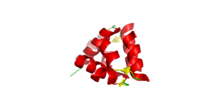| Relaxin 1 | |||||||
|---|---|---|---|---|---|---|---|
 | |||||||
| Identifiers | |||||||
| Symbol | RLN1 | ||||||
| Alt. symbols | H1 | ||||||
| NCBI gene | 6013 | ||||||
| HGNC | 10026 | ||||||
| OMIM | 179730 | ||||||
| RefSeq | NM_006911 | ||||||
| UniProt | P04808 | ||||||
| Other data | |||||||
| Locus | Chr. 9 qter-q12 | ||||||
| |||||||
| Relaxin 2 | |||||||
|---|---|---|---|---|---|---|---|
| Identifiers | |||||||
| Symbol | RLN2 | ||||||
| Alt. symbols | H2, RLXH2, bA12D24.1.1, bA12D24.1.2 | ||||||
| NCBI gene | 6019 | ||||||
| HGNC | 10027 | ||||||
| OMIM | 179740 | ||||||
| PDB | 6RLX | ||||||
| RefSeq | NM_134441 | ||||||
| UniProt | P04090 | ||||||
| Other data | |||||||
| Locus | Chr. 9 qter-q12 | ||||||
| |||||||
| Relaxin 3 | |||||||
|---|---|---|---|---|---|---|---|
| Identifiers | |||||||
| Symbol | RLN3 | ||||||
| Alt. symbols | ZINS4, RXN3, H3 | ||||||
| NCBI gene | 117579 | ||||||
| HGNC | 17135 | ||||||
| OMIM | 606855 | ||||||
| RefSeq | NM_080864 | ||||||
| UniProt | Q8WXF3 | ||||||
| Other data | |||||||
| Locus | Chr. 19 p13.3 | ||||||
| |||||||
| Insulin-like peptide 3 | |
|---|---|
| Identifiers | |
| Symbol | INSL3 |
| Other data | |
| Locus | Chr. 19 [1] |
| Insulin-like peptide 5 | |
|---|---|
| Identifiers | |
| Symbol | INSL5 |
| Other data | |
| Locus | Chr. 1 [2] |
Relaxin family peptide hormones in humans are represented by seven members: three relaxin-like (RLN) and four insulin-like (INSL) peptides: RLN1, RLN2, RNL3, INSL3, INSL4, INSL5, INSL6. This subdivision into two classes (RLN and INSL) is based primarily on early findings,[1] and does not reflect the evolutionary origins or physiological differences between peptides.[2] For example, it is known that the genes coding for RLN3 and INSL5 arose from one ancestral gene, and INSL3 shares origin with RLN2 and its multiple duplicates: RLN1, INSL4, INSL6.[2]
- ^ Sherwood OD (April 2004). "Relaxin's physiological roles and other diverse actions". Endocrine Reviews. 25 (2): 205–234. doi:10.1210/er.2003-0013. PMID 15082520.
- ^ a b Yegorov S, Good S (2012). "Using paleogenomics to study the evolution of gene families: origin and duplication history of the relaxin family hormones and their receptors". PLOS ONE. 7 (3): e32923. Bibcode:2012PLoSO...732923Y. doi:10.1371/journal.pone.0032923. PMC 3310001. PMID 22470432.